the john muir exhibit - bibliographic_resources - john_muir_bibliography - historical and literary analyses
Historical and Literary Analyses
Note:
Items shown in
boldface
are believed to be available for purchase
at the time this bibliography was last revised.
No attempt has been made to include entries from
encyclopedias or similar reference works.
Adams, Mark, Tip of the Iceberg: My 3,000-Mile Journey Around Wild Alaska, the Last Great American Frontier (Dutton 2018)
In 2016, travel writer Mark Adams set out to retrace the 1899 Harriman Alaska Expedition, on wh ich John Muir sailed with numerous other scientists and wrtiers, relying primarily on the state's intricate public ferry system, the Alaska Marine Highway System, supplemented by plane travel for the ocean portions, especially across the huge Bering Sea. This book melds the history of the Harriman Alaska Expedition, especially focused on John Muir and the other scientists aboard the 1899 steamship, and a fun and evocative form of travel writing into a seamless whole.
Austin, Richard Cartright,
Baptized into Wilderness: A Christian Perspective on John Muir
(Atlanta: John Knox Press, 1987).
This outstanding,
yet brief,
book by a Presbyterian minister explores Muir's religious expression
in his commitment to wilderness,
and leads the author to propose an environmental theology
that relates Christian faith to environmental concerns.
Does better justice to Muir in a scant 94 pages than many other works.
Highly recommended.
Badè, William F.,
Life and Letters of John Muir
(Boston: Houghton Mifflin, 1924)
(2 Vols.).
The Life and Letters of John Muir is included here, as well as under biographies, because this work by Muir's
literary executor, William Frederic Badè's work is comprised of
extensive extracts from Muir's unfinished autobiography and extensive excerpts of Muir's letters.
The Life and Letters of John Muir by William Frederic Badè were originally published by Houghton Mifflin in 1923 and 1924 in two volumes. It combines elements of John Muir's unfinished autobiography with letters selected from the voluminous correspondence between Muir and his many collaborators and admirers, linked by Badè's commentary.
In 1996, The Mountaineers in Seattle and Baton Wicks in London published a modern edition of The Life and Letters of John Muir, edited and introduced by Terry Gifford.
In 2022 and 2023, a 100th anniversary edition was published in print, ebook, and audiobook formats by Crazy Wisdom Publishing. Volume 1 Introduction and Preface by Michael Conti and Stephen Hatch. Volume 2 Introduction by Mike Wurtz and Epilogue by Harold W. Wood, Jr.
Learn more and watch video interview introductions of 2023 centennial edition here. (off-site link)
Barnett, Raymond, Earth Wisdom: John Muir, Accidental Taoist, Charts Humanity's Only Future on a Changing Planet (CreateSpace, 2016).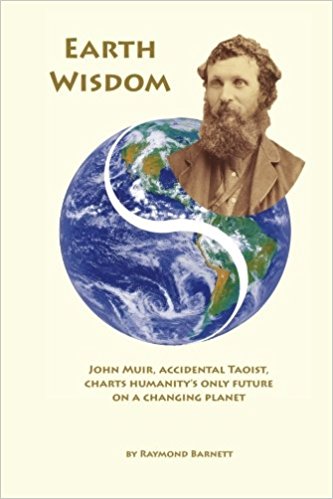
This book, in 3 main parts, is actually a combination of 4 books in one: (1) a biography, (2) a religious exegesis, (3) a history of the environmental movement, and (4) a Blueprint for Human Survival. The book is ambitious, but it seamlessly blends these seeming disparate components of history, biography, philosophy, and futurism into a highly persuasive argument for an entirely new approach to humanity's life on Planet Earth. Barnett's thesis is that "Muir's travels and observations engendered an immanent, this-worldly view, which finds ultimate meaning and glory in the natural world itself, in its physical array of creatures, elements, and processes - which included spirituality, beauty, and love." The author, a scientist in the field of evolutionary biology as well as being a Chinese scholar, proclaims that Muir's "Earth Wisdom" makes him as "accidental Taoist," - with a way of thinking that is also embraced by modern science. Dr. Barnett concludes that Muir's "Earth Wisdom" offers us a path - as individuals and as a society - to becoming whole and enlivened by connecting with our roots in the natural world. He argues, "If the looming catastrophe of climate change is to be resolved, Muir's two legacies - Earth Wisdom and the environmental movement - must both play key roles."
See Book Jacket Summary of Earth Wisdom
See Introduction and Reviews of Earth Wisdom on Raymond Barnett's Website. (off-site link)
See
Presentation and Book Review by Harold Wood on Raymond Barnett's book Earth Wisdom(off-site link)
Boone, "Ramblin" Ron, John Muir's "Thousand Mile Walk
to the Gulf" "Revisited". (Washington, PA: "Ramblin"
Ron Boone, 2006). ISBN No. 0910042969. 87 pp.; Illustrated, Preface,
Endnotes, Index.
This self-published book relates the author's physical re-tracing of
Muir's approximate waking route via a mini-camper. Each chapter includes
brief excerpts from Muir identifying the various towns he passed through;
Boone then elaborates on the history of each geographic area, both before
and after Muir's 1867 journey. Includes a line-drawn map, and 14 sketches
of various buildings seen along the route. While not really a scholarly
work, the endnotes include references to many reference books which elucidate
the history of the places Muir visited on his famous walk. Available
from online bookstores such as Amazon.com. See also Re-Tracing John Muir's Famous Walks.
Carrol, Theresa, John Muir Sings: A Collection of Scottish Airs Sung
by the Naturalist.
Illustrated by Nancy Carrol. (1978.) This out-of-print booklet contains
a general introduction about Muir's love for the Scottish language and
music, and individual introductions to each of ten traditional Scottish
songs showing their relationship to Muir, along with the complete lyrics
and musical notation. The traditional Scottish songs featured include "Gilderoy," "The
Cuckoo," "Oh! Why Left I My Hame?," "Highland Mary," "Thou Bonnie Wood of
Craigie Len," "The Banks o' Doon," "the Lass o' Gowrie," "O'er the Water
to Charlie," "Old Hundredth," and "For
A' That An' A' That."
Chapman, Dan, A Road Running Southward: Following John Muir's Journey through an Endangered Land, 256 pages 6 x 9 2 illustrations + auhor photos(Island Press, May, 2022)
One hundred and fifty years after John Muir's famous 1,000 mile walk to the Gulf of Mexico, veteran Atlanta reporter Dan Chapman, distressed by sprawl-driven environmental ills in a region he loves, recreates Muir's journey to see for himself how nature has fared since Muir's time. Chapman delves into the region's natural history, moving between John Muir's vivid descriptions of a lush botanical paradise and the myriad environmental problems facing the South today. Ultimately, "Chapman seeks to discover how Southerners might balance surging population growth with protecting the natural beauty Muir found so special." Publisher's Press Release (off-site link to Island Press). See also Re-Tracing John Muir's Famous Walks.
Christensen, Daryl, and McGwin, Kathleen, Muir is Still Here:
A Marquette County Journal of Discovery, 136 pages, 4 color maps,
color photographs, bibliography, softbound. Prepared for the "Year
of John Muir" - Montello Historic Preservation Society, P.O. Box 473,
55 West Montello St., Montello, WI 53949. www.kathleenmcgwin.com/montello-historic-preservation-society. © 2010.
Muir is Still Here brings to life in real, tangible form, the influences
in John Muir's young life in Marquette County, Wisconsin that helped shape
this great man's wilderness philosophy. Not strictly focused on history,
this book is part travel guide, with 4 color maps guiding you to four categories
of phenomena of special interest to Muir buffs: Geology & Geography; Early
Settler Sites; Birding Locations; and Wilderness Areas of Marquette County.
Part scrapbook, you will encounter historical and contemporary photographs,
toll road & ferry rates, cemetery epitaphs, copies of family letters, bird
lists, tree lists, wildflower lists, even recipes of some of Muir's favorite
boyhood treats! There's plenty of history here too, but the focus is on the
physical and spiritual geography of the landscape that Muir loved. Climb
Observatory Hill with the author, as Muir did as a boy, and discover a new
world! Highly recommended for anyone interested in celebrating the value
of a sense of place - anywhere.
We have a book jacket summary
of this book.
Cohen, Michael P.,
The Pathless Way: John Muir and American Wilderness
(Madison: Univ. of Wisconsin Press 1984).
This well-written,
thoughtful and scholarly study is focused
on Muir's character revealed through his writings.
A book jacket summary of this book is available.
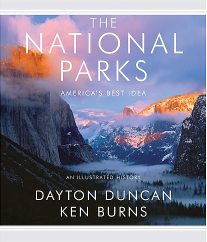 Duncan,
Dayton, The National Parks: America's Best Idea: An
Illustrated History (Based on a film by Ken Burns). (New York: Alfred
A. Knopf, 2009). Hardcover Book, 403 pages,
11" x 9.25" x
1.25". Illustrated, Bibliography, Index, tear-out Map of the National
Parks and Yosemite photo with Muir quote; Preface by Ken Burns. ISBN:
978-0-307-26896-9.
Duncan,
Dayton, The National Parks: America's Best Idea: An
Illustrated History (Based on a film by Ken Burns). (New York: Alfred
A. Knopf, 2009). Hardcover Book, 403 pages,
11" x 9.25" x
1.25". Illustrated, Bibliography, Index, tear-out Map of the National
Parks and Yosemite photo with Muir quote; Preface by Ken Burns. ISBN:
978-0-307-26896-9.
This is the companion book to the acclaimed 6-part Ken
Burns film documentary,
allowing in-depth study of the pictures, quotations, and stories introduced
in the film. Many will prefer this book to the film since it allows such
in-depth examination. Dozens of contemporary photos from the film and archival
historical pictures are included. The opening page, with an illustration
of lava flows on Hawaii' Volcanoes National Park, includes a selection of
several of Muir's most famous quotes. The author masterfully relates the
adventures and intense political battles behind the creation and protection
of the national parks. John Muir is one of the more famous persons featured
who have been transformed by these special places and committed themselves
to saving them from destruction so that the rest of us could be transformed
as well. Many, though by no means all, of the persons who have worked to
protect our national parks have been inspired by John Muir's example. As
Ken Burns states in the preface, "Muir's "new creed of nature" was
expressed in writings "so transcendent that millions of Americans are
still beguiled and inspired by the rapture flowing from his words." Terry
Tempest Williams, featured in numerous interviews in the film, is quoted
in this book as saying
"John Muir saw the spirituality inherent in granite. His view as a scientist
and his view as a deeply religious man were the same view. And I think it
was this integrity of life that inspired him, fueled him toward a cause greater
than himself." This book's author, Dayton Duncan, sums of Muir's role
this way in the After word: "John Muir is not lonely either. He has
lots of company - artists, housewives and scientists, descendents of slaves
and sea captains and sodbusters who felt the same 'natural beauty-hunger'
and satisfied that appetite in a national park. It's just that no one seems
to have done so with quite the same burning intensity as Muir." Extensive
quotations of many of the historical figures featured in the film are included,
and Muir is no exception. This book, like the film series, does not emphasize
the geology or natural history of the national parks, but rather the story
of the people who fought to preserve the parks.
Fleck, Richard F.,
Henry Thoreau and John Muir Among the Indians
(Hamden, Connecticut: Archon Books, 1985).
The author,
a professor of English at the University of Denver,
devotes considerable space in this small book about John Muir among the Digger,
Thlinkit, and Eskimoan People.
Fleck believes that the Indians of California and Alaska
confirmed Muir's belief in the need for a harmonious relationship with nature.
Includes a fascinating appendix of
Thoreau and Muir's unpublished manuscripts on primal cultures of the American Wilderness.
A book jacket summary of this book is available.
See more about Richard F. Fleck and his other writings about John Muir.
Fox, Stephen,
John Muir and His Legacy: The American Conservation Movement
(Boston: Little, Brown & Co. 1981).
The book begins with a biography of Muir,
making use of previously unavailable materials,
and concludes with an outstanding history of the American conservation movement,
focusing on the movement's volunteers.
Highly recommended.
A book jacket summary of this book is available.
Gisel, Bonnie Johanna, editor, Kindred and Related Spirits:
The Letters of John Muir and Jeanne C. Carr
Foreword by Ronald H. Limbaugh (The University of Utah Press, 2001)
Superb collection of the 30-year correspondence between John Muir and his
mentor, Jeanne C. Carr, who influenced Muir in his career, travels, and writing,
and in introducing him to notable people like Ralph Waldo Emerson. In addition
to correcting errors in the historical record, Gisel provides illuminating
chapter notes to the letters explaining and amplifying their content. More
than fifty photographs and illustrations, including many never-before published
botanical drawings by Carr, complement the text.
A publisher's press
release of this book is available.
Gisel, Bonnie Johanna, Nature’s Beloved Son, Rediscovering
John Muir’s Botanical Legacy, with images by Stephen J. Joseph
(Berkeley, Heyday Books, 2008).
See Our press release and book jacket summary for sample images and more information.
Goetzmann, William, and Kay Sloan Looking Far North: The Harriman Expedition to Alaska, 1899 (Viking, 1982).
Tells the story of how in 1899, railroad magnate Edward H. Harriman organized a summer voyage to the wilds of Alaska: He converted a steamship, the George W. Elder, into a luxury "floating university," populated by some of America's best and brightest scientists and writers, including John Muir. Those aboard encountered a land of immeasurable beauty and impending environmental calamity. This was Muir's seventh trip to Alaska, to Wrangell, Glacier Bay, Sitka, and Prince William Sound. Muir made many friendships on the vessel, and would later write stories about this trip, about the people on board, and the Natives. See also enries for Harriman Expedition Retraced and Tiip of the Iceberg.
Good, Cherry
On the Trail of John Muir
(Edinburgh: Luath Press Ltd. 2000)
This is not just another biography. Each stage of Muir's life and development is set within
the context of the places that were special, magical to him - the Canadian forests, the glaciers of
Alaska, Arizona's Grand Canyon, and most important of all, the High Sierra of California,
where the John Muir Trail now runs for over two hundred miles from Yosemite Valley to the
summit of Mount Whitney. By following the directions and maps included in this book readers are able to participate in Muir's adventures on both sides of the Atlantic, to gain some geographically-based insight into Muir's world.
Also available:
publisher's press release and photo of cover.
See also Re-Tracing John Muir's Famous Walks.
Henry, Daniel Lee, Across the Shaman's River: John Muir, the Tlingit Stronghold, and the Opening of the North. (University of Alaska Press (2017).
This book tells the story from both Native and Russian and American perspectives of one of Alaska's last Native American strongholds, a Tlingit community closed off for a century until a fateful encounter between a shaman, a preacher, and John Muir. Tucked in the corner of Southeast Alaska, the Tlingits had successfully warded off the Anglo influences that had swept into other corners of the territory. This tribe was viewed by European and American outsiders as the last wild tribe and a frustrating impediment to access. Missionaries and prospectors alike had widely failed to bring the Tlingit into their power. Yet, when John Muir arrived in 1879, accompanied by Presybyterian missionary S. Hall Young, it only took a speech by Muir about "brotherhood"—and some encouragement from the revered local shaman Skandoo'o—to finally transform these "hostile heathens." Using Muir's original journal entries, as well as historic writings of explorers juxtaposed with insights from contemporary tribal descendants, this book reveals how Muir's famous canoe journey changed the course of history and had profound consequences on the region's Native Americans.
Holmes, Steven J.
The Young John Muir : An Environmental Biography
336 pages (April 1999)
University of Wisconsin Press; ISBN: 0299161544
$55.00 hardcover; $22.95 paperback.
A scholarly analysis of John Muir's Youth, from age three in Scotland, to his early years in Yosemite in his early thirties. The author, a lecturer in history and literature at Harvard University, draws upon psychoanalysis, environmental psychology, cultural history, and religious studies to inform this work.
Huber, J. Parker, A Wanderer All My Days: John Muir in New England
357
pages, paperback. (Green Frigate Books, April, 2007). ISBN 978-0-9717468-4-8.
Traces the footsteps of John Muir on
his five trips to Boston and other parts of New England, including Vermont,
New Hampshire, and Maine, from 1893 to 1912. Huber meticulously uncovers the
places Muir stayed, the important people he met, the lectures he gave, and
the routes he took in the mountains of Maine and along the streets of Cambridge.
A book jacket summary of
this book is available.
Hunt, James B. Restless Fires: Young John Muir's Thousand-Mile Walk to the Gulf in 1867-68
(Macon, GA: Mercer University Press, 2012). Hardcover. Includes 14 images from John Muir's journal, Notes, Selected Bibliography, and Index, 235 pages. ISBN-10: 0881463922.
Provides a detailed rendering of Muir's thousand-mile walk based on both manuscript and published accounts. Hunt particularly examines the development of Muir's environmental thought as a young adult. Includes 14 photographic reproductions of pages from Muir's journal containing Muir's often whimsical drawings; three period photographs; and 1 modern (2011) map of Muir's route. As part of his research for the book, Hunt traveled Muir's route from Louisville, Kentucky, to Cedar Key, Florida beginning on September 1, 2007, discovering major and minor libraries and research institutions all along the route which aided in providing maps, diaries, newspapers,local histories, and other historical material relevant to the social, political, and economic contexts of the communities through which Muir passed in 1867. This is one of the first books on John Muir s thousand-mile walk that places his journey in the context of the Civil War and Reconstruction, to which Muir gave only passing witness. Through these experiences and reflections, Muir came to radical views regarding humankind s relationship to nature, death, and faith.
A book jacket summary of this book is available. See also Re-Tracing John Muir's Famous Walks.
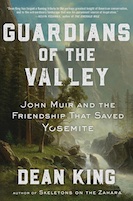 King, Dean, Guardians of the Valley: John Muir and the Friendship that Saved Yosemite (Scribner, March, 2023).
King, Dean, Guardians of the Valley: John Muir and the Friendship that Saved Yosemite (Scribner, March, 2023).
This book adds a new dimension to the scholarship and story-telling about John Muir by focusing on the friendship between Muir and Robert Underwood Johnson, the Eastern, urbane editor of Century Magazine. Sometimes forgotten that the effort involved both of these men, it was their collaboration that led to preserving Yosemite and making it a national park. As King shows, "without the instigation, cunning, and cajoling of the author-whisperer Johnson, himself a notable poet and man of letters, Muir would never have made the impact that he did." Never boring, the book allows us to re-live the fight to protect Yosemite and its many wonders from the ravages of commercial loggers, rapacious tourism developers, and municipal water thieves. Thankfully, Robert Underwood Johnson gave Muir a crucial platform to express his flaming tributes to nature. This book greatly enriches our understanding of both Muir and the early American conservation movement.
Limbaugh, Ronald H., John Muir's "Stickeen" and the Lessons of Nature (Fairbanks, AK: University of Alaska Press 1996). Black and White illustrations; Index. Appendix: "Notes on 'Stickeen' in John Muir's Library." 185 pp.
This book-length study of Muir's famous dog story "Stickeen" is more than the narrow focus the title suggests: the book uses "Stickeen" to show how Muir's literary creativity grew, and how it was influenced by major turn-of-the-century ideas and events. Moreover, Limbaugh notes that "Stickeen" is the only literary product from Muir's pen that can be directly and extensively linked to ideas formulated from the books of his personal library. Accordingly, "Studying its origin and evolution is essential to understanding Muir's development as a writer and as an advocate for the moral equality of all species."
A book jacket summary of this book is available.
Litwin, Thomas S., The Harriman Alaska Expedition Retraced: A Century of Change, 1899–2001, Foreword by David Rockefeller, Jr. (Rutgers University Press, March 14, 2005).
On July 22, 2001 over two dozen scientists, artists, and writers left Prince Rupert, British Columbia on the Harriman Expedition Retraced. The Clipper Odyssey followed the itinerary of E. H. Harriman's sailing with a team of scientists and writers, including John Muir, through the Inside Passage, the Gulf of Alaska, the Aleutian Archipelago, and northward through the Bering Sea, all the way to Nome. The Harriman Expedition Retraced was presented as a film and website presentation on PBS, (now available from Bullfrog Films), and as this book.
Lyon, Thomas J.,
John Muir
(Boise, ID: Boise St. University 1972).
48 pp.
A concise description of Muir and his writings
from the Boise State College Western Writers Series.
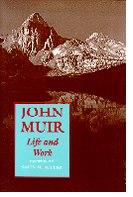 Miller, Sally R.,
Editor,
John Muir: Life and Work
(Albuquerque,
University of New Mexico Press,
1993).
Miller, Sally R.,
Editor,
John Muir: Life and Work
(Albuquerque,
University of New Mexico Press,
1993).
A collection of essays derived
from the third John Muir Conference at the University of the Pacific,
in 1990.
Explores Muir relationship with his family,
religious and literary influences on his philosophy,
the development of his concept of ecology,
his contributions to geology and botany,
and his travels in the Sierra,
Yellowstone,
and Australasia.
A publisher's press release is available.
Miller, Sally R.,
Editor,
John Muir in Historical Perspective
(New York: Peter Lang Publishing Inc., 1999)
Features the best presentations made at the California History Institute conference
on John Muir at the University of the Pacific in 1996, the fourth Muir conference
held in 16 years. Four chapters cover some of Muir's friends and traveling companions,
including the Strentzel family, Jeanne C. Carr, John Swett, and C.D. Robinson.
Three chapters feature literary themes, including Muir's religious environmentalism,
his role in the American Romantic movement, and his views on Ruskin. Four chapters
focus on the theme of Environment, including Muir's first summer in Yosemite,
his views on the geological formation of the Sierra, his influence on pioneer
conservationists in the Pacific Northwest, and his travels to South America and
southern Africa. An epilogue relates the re-discovery of Muir's "Twenty-Hill
Hollow." A scholarly work with valuable footnotes, the book includes a useful
index.
Also available:
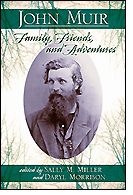 Miller, Sally M. and Morrison, Daryl, Editors, John Muir: Family,
Friends and Adventures (Albuquerque: University
of New Mexico Press, 2005)
Miller, Sally M. and Morrison, Daryl, Editors, John Muir: Family,
Friends and Adventures (Albuquerque: University
of New Mexico Press, 2005)
A collection of essays derived from the fifth
John Muir Conference hosted
by the John Muir Center at the University of the Pacific, held in 2001
at the Feather River Inn. Includes an Introduction by the conference
director, Bonnie Johanna Gisel. Topics cover Muir's relationship with contemporaries
Jeanne Carr, William Keith, Gifford Pinchot, John Swett, and with his
own family and children. Other essays cover Muir's adventures, including
his travels to Africa and South America, and the importance of his advocacy
for preserving the wilderness to our culture. This book includes more
photographs than previous editions in the series, some 28 images in total.
The publisher's
press release is also available.
The Pacific Historian,
The World of John Muir
(Stockton: Holt-Atherton Pacific Center for Western Studies,
University of the Pacific,
1981).
A fine collection of scholarly essays with historical photos and sketches,
by several notable Muir experts.
An illustrated book jacket summary (from the book's front matter), including the table of contents and author biographies is available.
The Pacific Historian,
John Muir: Life and Legacy
(Stockton: Holt-Atherton Center for Western Studies,
Univ. of the Pacific 1985).
This publications consists of twelve papers among 25 presented at a major conference held in 1985 at the University of the Pacific,
Stockton, CA.
Many of them broke new ground in Muir historiography by utilizing scholarly resources in the Muir-Hanna family collection at the University of the Pacific that had not been accessible before.
Palmer, Albert W., The Mountain Trail and Its Message (Originally published: Boston, The Pilgrim Press (1911); second edition reprinted Fresno: Sixth Street Press, (1997) with commentary by Charles P. Fisk.
This book, originally published n 1911, tells the story of the author's summer outings with the Sierra Club in the company of John Muir, the club's founder. Albert W. Palmer, at that time the young pastor of Plymouth Congregational Church in Oakland, California, went on to serve as president of Chicago Theological Seminary and write eleven more books after this, his first one. The lessons Palmer drew from his weeks in the Sierra Nevada are as fresh today as when they were written. For the second edition published in 1911, Palmer's grandson, Charles Palmer Fisk, an ardent hiker and Sierra Club member, has provided an introduction, extensive notes, and thirteen photographs to supplement the seven taken by his grandfather, copied from the first edition. This 1997 edition also contains a Letter from John Muir to Albert Palmer, an extensive Epilogue by Palmer's great-grandaughter, Holly Van Houten, a Letter from John Muir to Walter Palmer dated November 9, 1908, Biographical Notes about Contributors to the Second Edition, and Suggested References. Use caution in purchasing: though the book is listed on several sources as being available in hardbound, paperback, or as a Kindle ebook on Amazon.com, those editions appear to be a simple reprint of the 1911 edition rather than the Sixth Street Press edition of 1997 with the added commentary by Palmer's grandson Fisk, his granddaughter Holly Van Houten, and additional notes and photographs.
First edition is also available free online from openlibrary.org
Available on this site from the 1911 edition: A
Parable of Sauntering which includes Palmer's account of a conversation
with John Muir, who told Palmer he hated "hiking" - both the word
and the thing!
A book jacket summary of this book is available,
A press release for this book is also available.
An audiobook edition is available on YouTube, read by Bo Greigh, posted by Warren Smith, on YouTube.
Pomeroy, Elizabeth, John Muir: A Naturalist in Southern California
(Pasadena: Many Moons Press, 2001) 148 pages, soft cover. Illustrated with historic photographs and original drawings by Pasadena artist Joseph Stoddard.
This important book tells the story of Muir's visits to southern California, and his many friends there, including Ezra and Jeanne Carr, Theodore Lukens, Charles Lummis, John and Katherine Hooker; and his hob-nobbing in Pasadena with such notables as Andrew Carnegie, John Burroughs, and Theodore Roosevelt. The text is thorough and engaging, and is further enhanced by the inclusion of correspondence between Muir and his southern California friends, and transcripts of historical newspaper articles about Muir's visits to southern California. A nice final touch is the summary of several places in southern California associated with Muir which are available to visit. This is the expanded, wide-release edition of the next listing.
Also available:
Publisher's press release and ordering information.
Pomeroy, Elizabeth,
John Muir in Southern California
(Pasadena: The Castle Press, 1999)
See listing above for the current edition of this out-of-print book.
This edition is a limited edition (500 copies) book of 63 pages, with 23 photographs
of Muir and places associated with him, many previously unpublished, and includes
detailed notes on sources. Tells the story of Muir's visits to southern California,
and his many friends there, including Ezra and Jeanne Carr, Theodore Lukens,
Charles Lummis, John and Katherine Hooker; and his hob-nobbing in Pasadena with
such notables as Andrew Carnegie, John Burroughs, and Theodore Roosevelt. The
final chapter tells of Muir's final days in Daggett, in the Mojave Desert. A
final chapter summarizes several places in southern California associated with
Muir, such as the long-gone John Muir Lodge in Big Santa Anita Canyon of the
San Gabriel Mountains, and newly re-dedicated Muir Peak near Mt. Wilson. This
edition has been superseded by the above - listing, which has been expanded and
improved with additional illustrations.
Smith, Herbert,
John Muir
(Twayne U.S. Authors Series)
Reprint of 1964 edition.
(New York: NCUP, Inc.).
This literary analysis is rather dated,
and is largely grounded upon the author's typifying Muir as Transcendentalist.
Stanley, Millie,
The Heart of John Muir's World: Wisconsin, Family, and Wilderness Discovery
(Madison: Prairie Oaks Press,1995).
Paperback,
$16.95.
This intimate study of Muir focuses on his life-long close relationships
with family members and friends,
showing that Muir loved people as much as the Wilderness.
A
publisher's press release about this book is available.
Thomas, Peter and Donna, Muir Ramble Route: Walking
from San Francisco to Yosemite In the Footsteps of John Muir - A guide
for hiking from San Francisco to Yosemite by Peter and Donna Thomas With
an account of the original 1868 trip by John Muir . (Madera, CA: Poetic
Matrix Press, 2010). Paperback, Hiking Guide $17.00.
This book is really
three books in one. It is a guidebook for a walking/cycling route across
California that follows John Muir's footsteps from San Francisco to Yosemite
via the Pacheco Pass. It is an adventure book, telling the story of Peter
and Donna Thomas' 2006 ramble across California to discover that route.
And finally it is a history book, presenting in its entirety and for
the first time, the complete story of John Muir's first trip to Yosemite.
That trip was taken in 1868, the year before Muir's 'First Summer in
the Sierra,' and it has never been published before, existing in obscurity,
in Muir's various writings, until it was reconstructed by Peter and Donna
in preparation for their walk to Yosemite in his footsteps.
A photo of the
cover of the book featuring John Muir and a book jacket summary is available. See also Re-Tracing John Muir's Famous Walks.
Turner, Frederick W.,
John Muir: Rediscovering America
originally published as
Rediscovering America: John Muir in His Time and Ours
(New York: Viking Penguin, and San Francisco: Sierra Club Books 1985). This book has been re-published in September, 2000, by Merloyd Lawrence Book/ Perseus Publishing as ISBN is 0-7382-0375-0..
This modern scholarly biography is especially valuable for its presentation
of Muir in the historic context of his times.
A photo of the cover of the book featuring John Muir and a book jacket summary is available.
Vale, Thomas R., and Geraldine R. Vale,
Walking With Muir Across Yosemite
(Madison: University of Wisconsin Press, 1998).
Essays and natural history tracing Muir's travels in Yosemite.
Walker, Franklin, San Francisco's Literary Frontier (New York: Alfred A. Knopf, 1939).
This book covering hundreds of writers has only a brief statement about John
Muir. Walker provides a brief biographical sketch of Muir's life and his writing.
He sums up Muir's writing thusly: "His style was marked by a flair for unusual
metaphors and an intensity which at its worst produced the over florid, at its
best the phrase that glowed. In John Muir's work, man and style were indistinguishable."
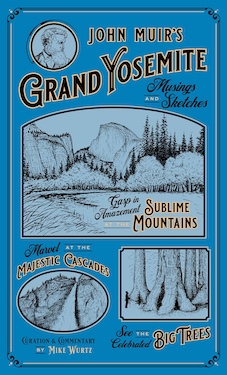 Wurtz, Mike,John Muir's Grand Yosemite: Musings & Sketches (Yosemite Conservancy, 2020).
Wurtz, Mike,John Muir's Grand Yosemite: Musings & Sketches (Yosemite Conservancy, 2020).
Features locations where Muir made sketches, journal entries, and later articles and books. A brief passage by Muir accompanies each of Muir's drawings, paired with information identifying and revisiting the same locations today. Twenty-five of the scenic places that Muir sketched are included in this unique guide designed so that visitors can follow in Muir's footsteps. Includes easy-to-follow directions plus a simple map for planning an itinerary. For a preview of the book, see Wurtz's recorded YouTube presentation on Yosemite Through John Muir's Drawings from August 6, 2020.
Home
| Alphabetical Index
| What's New & About this Site